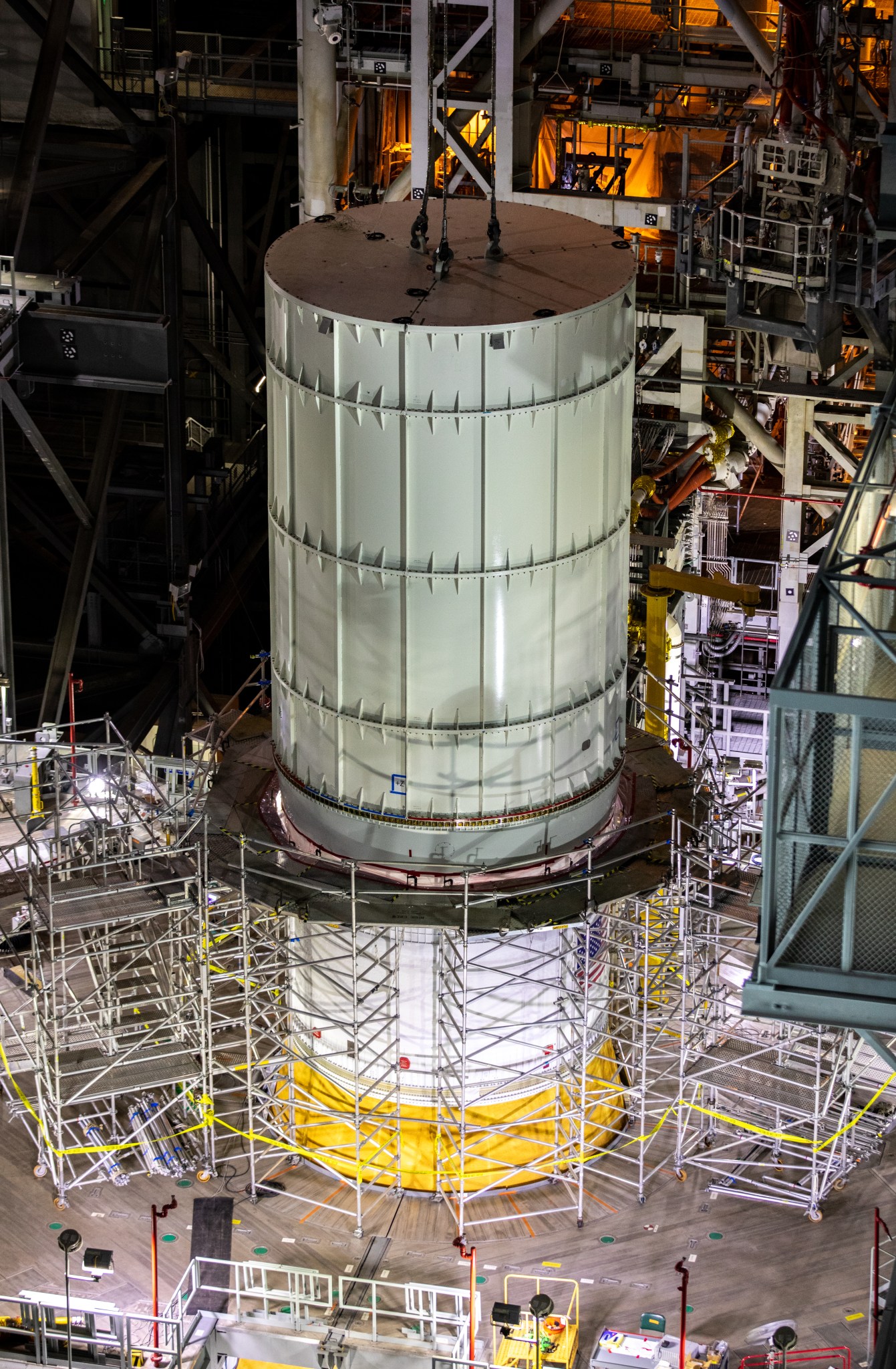
Driving down a bumpy gravel road, even an off-road vehicle experiences bumps and vibrations, partly because of the car’s natural frequency. An object’s natural frequency is the frequency or rate that it vibrates naturally when struck. When forces like speed and the smoothness of the road are just right, the car will vibrate in tune with that same frequency.
Rockets flying through the atmosphere to space, including NASA’s Space Launch System (SLS), are no different. They have natural frequencies and experience dynamic forces during launch and ascent. Understanding those frequencies and what they look like is critical to steering SLS and the Orion spacecraft safely through the atmospheric “road” to space.
To safely control the rocket’s flight, the flight software and navigation system must distinguish the rocket’s natural frequencies from the vibration frequencies experienced during flight. That’s why teams at NASA’s Kennedy Space Center in Florida are performing integrated modal testing to determine the different modes of vibration with the recently stacked, integrated SLS rocket before launch of the Artemis I mission.
“We will use the modal testing data for multiple purposes,” said Dr. John Blevins, SLS chief engineer. “We will compare the physical results with what computer models predicted. The information will also be fed into the flight computers so when SLS is flying, the computers know which vibrations are natural to the rocket and which are caused by external forces. The computers will use that information to steer the rocket, ensuring it is placed in the right orbit and does not unnecessarily deplete its fuel by reacting to natural vibrations the rocket should ignore.”
The Exploration Ground Systems (EGS) and Jacobs team at Kennedy along with the SLS team from NASA’s Marshall Space Flight Center in Huntsville, Alabama, perform the tests on the mobile launcher and SLS stack in the Vehicle Assembly Building (VAB) with support from personnel at other NASA centers. In the VAB, the assembled rocket is comprised of the solid rocket boosters, core stage, Interim Cryogenic Propulsion Stage (ICPS), Orion stage adapter structural test article, and mass simulator for Orion. Engineers are using the mass simulator for Orion and the Orion stage adapter structural test article for the modal test series while the Orion spacecraft undergoes assembly of its launch abort system and the CubeSat payloads are loaded into the Orion stage adapter for flight. The test hardware has the same weight characteristics as their respective flight components, which is important for this test.
“Approximately 300 sensors are attached to the rocket and mobile launcher to detect, record, and transmit the information,” said Cliff Lanham, senior vehicle operations manager for EGS at Kennedy. “Instrumentation is installed both internally and externally to the rocket including the boosters.”
The motion pattern of a system vibrating at its natural frequency is called the normal mode. To identify the SLS’s natural frequencies, the team places hydraulic shakers in seven locations on the rocket. A small hammer will deliver calibrated taps near key parts of the navigation system to understand the dynamics local to those spots. A hammer on a dolly will move to different locations on the mobile launcher to impart further vibrations.
For 10 hours a day, several days in a row, the team will conduct the test program. They will take advantage of the overnight shift in the VAB, when activity level is low. This quiet setting helps engineers verify the vibrations detected by the sensors are caused by the tests and not by other activities in the cavernous facility or on nearby roads. Some of the tests involve multiple vibration frequencies at the same time – like a guitar producing multiple notes at once – while other tests focus on a specific frequency. Following each round of tests, engineers will analyze the data and plan any adjustments needed for the next test.
While the official test series will end after the multi-day program, the sensors will continue collecting data during rollout of the flight stack to Launch Complex 39B, which will include the flight version of the Orion stage adapter with CubeSat payloads and the Orion spacecraft. Sensors will also collect data during the wet dress rehearsal – a practice run of launch countdown, including filling the core stage and ICPS fuel tanks with super-cooled liquid hydrogen and liquid oxygen propellants.
“We will use the data collected from the modal sensors to cross-check, update, and validate the integrated SLS structural dynamic math models, which then provides confirmation and confidence of the vehicle design for guidance, navigation, control and loads during launch,” said Liliana Villarreal, operations flow manager for the EGS. “Bottom line: This test will help ensure we are ready to fly and safely navigate the atmospheric road to the stars.”
Teams are performing integrated modal testing in advance of the Artemis I mission – the first integrated flight of SLS and Orion. The mission will send the Orion spacecraft deeper into space than any spacecraft built for humans has ever flown.
To learn more about SLS, visit:
https://www.nasa.gov/exploration/systems/sls/index.html
To learn more about the Artemis I mission, visit:


























